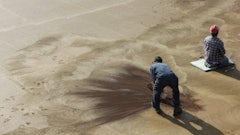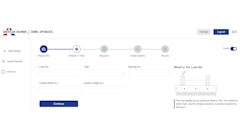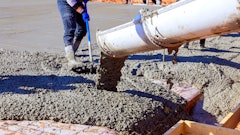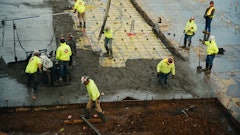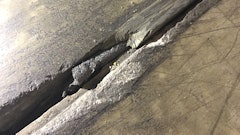
“Area doesn’t meet surface profile tolerances”, is not what you want to see on an FF/FL report as a commercial concrete flooring contractor. The moment a test agency submits a failing report, things get serious, and people are looking for answers.
While bad service, mix issues, and equipment problems are the usual suspects, few people question the test itself. That’s especially true when the results are put together in a well-formatted, official-looking, report that just has an unquestionable air of authenticity about it.
In this article, I’d like to cover three easy-to-spot testing mistakes that happen during data collection with a walking floor profiler that can be identified at a glance and greatly affect your run scores. As a concrete contractor or testing agency, your ability to detect these mistakes can be of great value, especially if the mistake makes the difference between a passing or failing score on a floor.
3 Easy-to-Spot Testing Mistakes
- A reading was taken in the air.
- Accidentally measuring an object stuck to the floor.
- Bad calibration/something stuck to the footpad.
The first step to seeing these is to get your hands on the profile graphs (or plot). Every profiler on the market can produce these graphs. They may look slightly different, but they all display the same information in nearly the same way. The question is, whether or not the test agency provided them with the report. It would be best if pre-pour, the testing agency is informed that you want these graphs included with every report produced for that project. If you know how to read them, they can tell you a lot about screed settings, forming, and even laser issues (which may be an article for another time). For now, let’s get back to the three issues and how to see them on the profile graphs.
To see them you first need to understand what a profile graph is and how to read it. Profile Graph 1 is a profile graph from a real run on a real floor taken with a walking profiler.
 Profile Graph 1Somero Matson Group
Profile Graph 1Somero Matson Group
For each step taken with the profiler, an angle is captured and translated into an elevation reading. That is then plotted on a graph. As you walk the profiler, captured data creates a profile of the actual floor, hence the name “floor profiler.” In this example (Profile Graph 1), 60 readings were taken. The distance is plotted along the X-axis. The spacing on the footpads on the profiler was 12 in. which can provide us the total length of the run, 60 ft. The elevation reading for each step is plotted on the Y-axis. Runs always start from zero and then elevation is added or subtracted to the subsequent reading. In summary, the entire run of measurements fell within a 0.174-in. envelope. (Which is around 3/16 in. for those who are like me and have a hard time with decimals.)
Couple that with the FF/FL score reported for this run of FF 65.5 and FL 64.74, you will be able to better understand everything you need to know to quickly identify the three issues. (For brevity’s sake, we’ll not be covering how FF/FL is calculated using this information in this article).
Pro tip: Go on Amazon or Harbor Freight and get yourself a pair of cheap digital calipers. You can quickly set it to 0.174-in. to physically see what that looks like in fractions of an inch, and for future reports where you are trying to figure out just how big a bump is.
 Profile Graph 2Somero Matson Group
Profile Graph 2Somero Matson Group
A Reading was Taken in the Air
Whenever you see a profile plot that has a ledge that steps up in one reading (sharp line up within one reading per 12 in.) as seen in Profile Graph 2 at the 30 mark data point, it’s likely a false reading that was taken in the air. This happens when the profiler collects a reading before its footpad is in contact with the ground. Another way to create a profile like this is if the operator literally stepped up onto a higher surface with the profiler at this point in the floor. Either way, you have a problem.
To show the impact of this, we added 0.25 in. to one single point using the same data from the baseline data run seen in Profile Graph 1. Remember the baseline run measured FF 65.5 and FL 65.74. That same run with just a 0.25-in. reading in the air has now dropped the score to FF 28.1 FL 30.13. This one mistake cut your score in half for that run.
 Profile Graph 3Somero Matson Group
Profile Graph 3Somero Matson Group
Stepping on an Object
If you ever have a sharp up and down spike in a graph for one reading it means that the profiler foot was actually on something when two readings were taken. To create this, the profiler takes a reading as it steps onto an object and then when it steps off. Something stuck to the floor or footpad for a single reading can cause this. If you ever see it on a graph, simply ask the testing agency to take you to the location of the floor where they took this measurement and show you the object they stepped up on.
For this example (Profile Graph 3, note the spike at the 30 mark data point), using the baseline run again but added a 0.25-in. step up and a 0.25-in. step down. The rest of the data was the same. The run now drops to a score of FF 17.7 and FL 53.18.
Trust me this can happen. Especially if a profiler was walked or rolled through debris on the floor. For example, a contractor sent a video of someone rolling a profiler directly through a pile of dust left from saw cutting.
 Profile Graph 4Somero Matson Group
Profile Graph 4Somero Matson Group
Bad Calibration / Something Stuck to the Footpad
Simply put, one side of the profiler is reading higher than it should be. This can be due to a bad calibration or something physically stuck to one foot for the run. In either case, it creates a “sawtooth” pattern (see Profile Graph 4) in the readings on a walking profiler. Adding 0.0625 in. (1/16 in.) to one side does to the baseline run measurements now scores an FF 11.4 and FL 65.74.
When you know what to look for these issues stick out like a sore thumb. As a concrete contractor, it's always in your best interest to ask for the profile graphs and to start looking for them. It could mean the difference between passing or failing.









